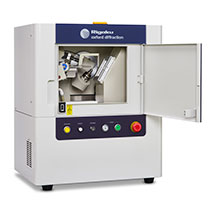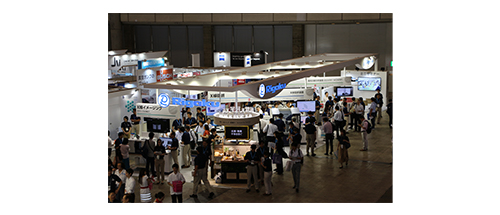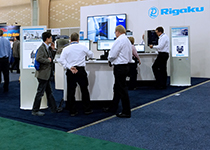| Benchtop chemical crystallography system for 3D small molecule structure determination |
 |
| XtaLAB mini II |
The Rigaku XtaLAB mini II benchtop X-ray crystallography system is a compact single crystal X-ray diffractometer designed to produce publication-quality 3D structures. The perfect addition to any
synthetic chemistry laboratory, the XtaLAB mini II will enhance research productivity by offering affordable structure analysis capability without the necessity of relying on a departmental facility. With the XtaLAB mini II, you no longer have to wait in line to
determine your structures. Instead your research group can rapidly analyze new compounds as they are synthesized in the lab.
For more > |
|
| Interested in publishing your work in The Bridge? |
 |
| Publish Your Work Here |
| The Bridge now welcomes manuscripts, communications, and papers that describe techniques and applications of all forms of X-ray fluorescence (XRF) and X-ray diffraction (XRD, including SAXS) that are of interest to fellow scientists in industry, academia, and government. Manuscripts, in PDF format, are only accepted with the understanding that they are not commercial in nature. Authors are responsible for all statements made in their work. If illustrations or other material in a manuscript have been published previously, the author is responsible for obtaining permission to republish. Please email copy to the editor.
|
|
| Elemental analysis of solids, liquids, powders, alloys and thin films |
 |
| Supermini200 |
| As the world's only high-power benchtop sequential wavelength dispersive X-ray fluorescence (WDXRF) spectrometer for elemental analysis of oxygen (O) through uranium (U) of almost any material, the Rigaku Supermini200 uniquely delivers low cost-of-ownership (COO) with high resolution and lower limits-of-detection (LLD).
For more > |
|
| Video of the Month |
 |
| Behind-the-scenes look at CERN, the world's largest particle physics laboratory |
| This month's video covers a special live broadcast from CERN, the European Organization for Nuclear Research that operates the largest particle physics laboratory in the world.
For more > |
|
|
|
| Useful Link of the Month |
 |
| Chemicool Periodic Table |
This is an all-purpose, interactive periodic table that would be useful for high-school chemistry classes. In addition to general information about the elements, it includes the following: states, energies, oxidation and electrons, appearance and characteristics, reactions, conductivity, abundances, and more.
Access Chemicool Periodic Table online or download from the App Store or Google Play.
|
|
| Planning to submit a grant? |
 |
| Rigaku is happy to assist |
| If you are planning on submitting an instrument grant proposal, Rigaku will be happy to assist you. We can help you determine the correct instrument and configuration best suited for your analytical needs.
Start the process >
|
|
| Rigaku's Materials Analysis eNewsletter, The Bridge |
 |
| Join us |
| Each month, Rigaku distributes two eNewsletters: The Bridge, which focuses on Materials Analysis, and Crystallography Times, which concentrates on X-ray crystallography.
Join us >
|
|
|
|
Welcome
The Bridge takes this opportunity to invite our readers to attend Rigaku Americas Corporation's 3rd Regional Seminar on X-ray Microscopy on Wednesday October 30th at our headquarters in The Woodlands, TX. The full-day program will focus on the latest advances in X-ray microscopy and feature presentations from top-level innovators in the field. A group lunch will be provided along with an afternoon workshop using state-of-the art instrumentation and software. Registration is
free but seating is limited.

October is a slower event month, but there are several to note in the US. For those in the petrochemical arena, please come visit us at the Gulf Coast Conference (Oct 15 – 16, Galveston, TX, booths 102,104 and 106). Also, the American Chemical Society is hosting two regional conferences in Wichita, KS and Savannah, GA. A complete list of all upcoming events can be found here.

Over 3,000 visitors visited the Rigaku booth at JASIS2019
Application Notes and Technical Articles for the month feature articles on Material characterization by PDF and RDF analysis (XRD), Analysis of Trace Elements in Environmental Water (TXRF), Large meso-Pentafluorophenyl-Substituted Expanded Porphyrins (SCX), Advanced ZSX Guidance—Semi-quantitative analysis (WDXRF), and Sulfur in Bunker Fuel (EDXRF).
The book review covers The Second Kind of Impossible: The Extraordinary Quest for a New Form of Matter by Paul J. Steinhardt. Our video
provides a behind-the-scenes look at CERN, while the useful link is to a Periodic Table app. And, as always, the news and papers sections are at the bottom of the page for a taste of the latest developments in materials science.
R.C. Tisdale, Ph.D. – Editor
 |
|
Featured Rigaku Journal Article
Advanced ZSX Guidance—Semi-quantitative analysis
(SQX analysis)
Rigaku Corporation
WDXRF spectrometers have high spectral resolution and can therefore identify peaks with high accuracy. However, if the analysis line overlaps with a higher order line, peak identification and semi-quantitative analysis results may not be reliable. To perform accurate analysis for such cases, measurement conditions that reduce the influence of the higher order lines need to be set up, followed by remeasuring the sample with the optimized conditions.
Full article > |
 |
|
XRD Application Note
Material characterization
by PDF and RDF analysis
Rigaku Corporation
Pair Distribution Function (PDF) and Radial Distribution Function (RDF) analyses can derive atomic distances
and atomic coordinates from an X-ray diffuse scattering pattern regardless of the crystallinity of the materials. Therefore, it is possible to perform the analysis for amorphous materials and nanomaterials that present broad peaks called halos.
For more > |
 |
|
TXRF Application Note
Analysis of Trace Elements in Environmental Water
Rigaku Corporation
In the TXRF method, simple sample preparation requires only pipetting the liquid sample onto a carrier. Multiple elements can be analyzed simultaneously using the internal standard method without preparing calibration curves. Compared to conventional analysis methods such as atomic absorption spectrometry (AAS) and induced coupled plasma optical emission spectrometry (ICP-OES), TXRF method has advantages in time and cost for analysis. In this report, trace elements in environmental water samples were analyzed by the TXRF method.
For more > |
 |
|
EDXRF Application Note
Marine Fuels Analyzer
Applied Rigaku Technologies
Regulations limiting the sulfur content of fuel used in the marine industry continues to evolve. As of January 1, 2015 the revised Annex VI to Marpol 73/78 reduced the
maximum sulfur content allowed when entering ECA's
(Emission Control Areas) to 0.1 wt%. After January 1, 2020 new IMO regulations require the sulfur content of any fuel used on board ships not to exceed 0.5 wt%. This is a substantial reduction from the 3.5 wt% limit established January 1, 2012.
For more > |
 |
|
SCX Application Note
Large meso-Pentafluorophenyl-Substituted
Expanded Porphyrins
Rigaku Oxford Diffraction
Porphyrin analogs having five or more pyrrole rings is referred to as a ring-extended porphyrins. They have
been found to have a variety of interesting properties diverting from those of porphyrin. Whilst porphyrin
has a planar structure, the ring extended porphyrins take on a twisted structure due to both its flexibility and by the presence of hydrogen bonds among NH groups. The flexibility of the structure increases with
increasing ring size meaning that structures of these large twisted compound are difficult to predict. Precise
structure can only be determined by way of single crystal X-ray structure analysis. The three-dimensional
structural of compounds having more than ten pyrrole rings has rarely been reported, because structure
analysis of such a huge twisted aromatic compounds are generally cumbersome.
For more > |
 |
|
Book Review
The Second Kind of Impossible: The Extraordinary Quest for a New Form of Matter
By Paul J. Steinhardt
The Second Kind of Impossible starts with Paul J. Steinhardt's 2011 expedition to the Kamchatka Peninsula in Russia. Being swarmed by mosquitoes and traipsing through muck while conducting research out in the field sounds like a typical day in the life of a wildlife biologist—not a renowned Princeton physics professor such as Steinhardt. Already, by page 2, he has the reader hooked—what on Earth was he doing there, and what was he looking for? Read review > |
 |
|
Material Analysis in the News
News for September 2019
September 1, 2019. Mitsubishi Electric Corporation announced that in collaboration with the Research Center for Ubiquitous MEMS and Micro Engineering, National Institute of Advanced Industrial Science and Technology (AIST), it has developed a gallium nitride-high electron mobility transistor (GaN-HEMT) in a multi-cell structure bonded directly to a single-crystal diamond heat-dissipating substrate with high thermal conductivity.
September 3, 2019. Japan's National Museum of Nature and Science has added 26 products to a list of innovations that shaped industries and changed the way people live. The list of Essential Historical Materials for Science and Technology commemorates technology produced in Japan.
September 3, 2019. Toyohashi University of Technology has developed a novel liquid process for fabrication of an affordable multiferroic nanocomposite film in collaboration with Japan Fine Ceramics Center, National Institute of Technology Ibaraki College, International Iberian nanotechnology Laboratory, Chang'an university and University of Erlangen-Nuremberg. The multiferroic material obtained by the novel process possesses strong correlation between the electric and the magnetic properties.
September 3, 2019. Japan is the world's strongest nation in parts and materials for semiconductors, automotive parts and optical products, an analysis has found. The study analyzed changes in the number one patented products of five countries, including Korea, the United States, Japan, Germany, and China, based on product data extracted from U.S. patents over the past 10 years.
September 12, 2019. Research Associate Hironari Isshiki and his team from the University of Tokyo's Institute for Solid State Physics have found a novel fabrication method for spintronic devices that is interesting because it uses organic molecules
that are relatively easy to configure for different purposes. Layers of molecules could be painted or printed onto metals to create new electronic functions.
September 13, 2019. Japan Science and Technology Agency announces expanded research and development project to support wireless charging systems for electric vehicles. Program will help contribute to the realization of a low-carbon society through a reduction of CO2 emissions.
September 13, 2019. South Korea's state funding for research and development in materials, components and equipment would be doubled next year as the government goes all out to build a self-sufficient value chain. The Ministry of Science and ICT proposed a state subsidy of 300 billion won ($251.7 million) up from this year's 160 billion won.
September 15, 2019. Japan's largest companies have signed up to new environmental disclosures at a faster rate than their European and US rivals, as Tokyo prepares to ramp up its implementation … before the 2020 Olympics.
September 18, 2019. Single-walled carbon nanotubes should theoretically be extremely strong, but it remains unclear why their experimental tensile strengths are lower and vary among nanotubes. A team at Nagoya University, Kyoto University, and Aichi Institute of Technology directly measured the tensile strengths of individual structure-defined single-walled carbon nanotubes, revealing key insights into the relationship between their structure and strength
September 18, 2019. Data centers are processing data and dispensing the results at astonishing rates and such robust systems require a significant amount of energy. A team of researchers at Yokohama National University have developed a digital logic process called Adiabatic Quantum-Flux-Parametron (AQFP) to reduce energy consumption. The idea
is that direct current should be replaced with alternating current.
|
 |
|
Recent Scientific Papers of Interest
Papers for September 2019
Recent Scientific Papers of Interest is a monthly compilation of material analysis papers appearing in recently released journals and publications. See below |
2019 atomic spectrometry update – a review of advances in X-ray fluorescence spectrometry and its special applications. Vanhoof, Christine; Bacon, Jeffrey R.; Ellis, Andrew T.; Fittschen, Ursula E. A.; Vincze, Laszlo. JAAS (Journal of Analytical Atomic Spectrometry). Sep2019, Vol. 34 Issue 9, p1750-1767. 18p. DOI: 10.1039/c9ja90042j.
Structural analysis of hydrogenated nano-crystalline silicon suboxide (nc-SiOx:H, x<1) thin films with SAXS for a potential application as phase change material. Bam, Begüm Çinar; Rüzgar, Kemal; Bacioglu, Akin; Ide, Semra. Surface & Coatings Technology. Sep2019, Vol. 374, p164-170. 7p. DOI: 10.1016/j.surfcoat.2019.05.083.
Optimization of a primary X-ray filter for X-ray fluorescence analysis of uranium and plutonium. Ishii, Kota; Izumoto, Yukie; Matsuyama, Tsugufumi; Fukutsu, Kumiko; Sakai, Yasuhiro; Oguri, Yoshiyuki; Yoshii, Hiroshi. XRS: X-ray Spectrometry. Sep/Oct2019, Vol. 48 Issue 5, p360-365. 6p. DOI: 10.1002/xrs.3067.
Trace determination of uranium preconcentrated using graphene oxide by total reflection X-ray fluorescence spectrometry. Takahashi, Hiroaki; Izumoto, Yukie; Matsuyama, Tsugufumi; Yoshii, Hiroshi. XRS: X-ray Spectrometry. Sep/Oct2019, Vol. 48 Issue 5, p366-374. 9p. DOI: 10.1002/xrs.3032.
Tracking the dimensional conversion process of semiconducting lead bromide perovskites by mass spectroscopy, powder X-ray diffraction, microcalorimetry and crystallography. Hu, Yue-Qiao; Hui, Hong-Yan; Wen, Hong-Qiang; Wang, Yanyan; Lin, Wei-Quan; Yang, De-Suo; Feng, Guo-Dong. Dalton Transactions: An International Journal of Inorganic Chemistry. 9/7/2019, Vol. 21 Issue 17, p12888-12894. 7p. DOI: 10.1039/c9dt02068c.
Thermal analysis and high-temperature X-ray diffraction study of BiNbO₄. Zhuk, N. A.; Makeev, B. A.; Belyy, V. A.; Krzhizhanovskaya, M. G. Journal of Thermal Analysis & Calorimetry. Sep2019, Vol. 137 Issue 5, p1513-1518. 6p. DOI: 10.1007/s10973-019-08070-6.
Trace determination of uranium preconcentrated using graphene oxide by total reflection X-ray fluorescence spectrometry. Takahashi, Hiroaki; Izumoto, Yukie; Matsuyama, Tsugufumi; Yoshii, Hiroshi. XRS: X-ray Spectrometry. Sep/Oct2019, Vol. 48 Issue 5, p366-374. 9p. DOI: 10.1002/xrs.3032.
Matrix correction with Compton to Rayleigh ratio in a plant–soil–rock interface analysis using a laboratory micro-XRF. Shen, Yating; Luo, Liqiang; Song, Yufang; Liu, Jian; Lao, Changling; Sun, Menghe; Yang, Wenlei. XRS: X-ray Spectrometry. Sep/Oct2019, Vol. 48 Issue 5, p536-542. 7p. DOI: 10.1002/xrs.3080.
XRF analysis of strontium: Exploring cellulose as a soft tissue equivalent. Gevaert, Julia; Chettle, David R. XRS: X-ray Spectrometry. Sep/Oct2019, Vol. 48 Issue 5, p443-451. 9p. DOI: 10.1002/xrs.3025.
Characterization of Cu₂O/TiO₂NTs nanomaterials using EDXRF, XRD and DRS for photocatalytic applications. Sarto, Gabrielle; Lopes, Fábio; dos Santos, Felipe R.; Parreira, Paulo S.; Almeida, Lucio C. Applied Radiation & Isotopes. Sep2019, Vol. 151, p124-128. 5p. DOI: 10.1016/j.apradiso.2019.04.036.
Mechanical alloying of Si and Fe: Quantum-mechanical calculations applied to Mössbauer and X-ray diffraction studies. Dobysheva, L. V. Journal of Applied Physics. 9/7/2019, Vol. 126 Issue 9, pN.PAG-N.PAG. 11p. 1 Color Photograph, 4 Charts, 4 Graphs. DOI: 10.1063/1.5095566.
Can spectral analyses improve measurement of key soil fertility parameters with X-ray fluorescence spectrometry? Nawar, Said; Delbecque, Nele; Declercq, Ynse; De Smedt, Philippe; Finke, Peter; Verdoodt, Ann; Van Meirvenne, Marc; Mouazen, Abdul M. Geoderma. Sep2019, Vol. 350, p29-39. 11p. DOI: 10.1016/j.geoderma.2019.05.002.
Enhancing counterfeit and illicit medicines grouping via feature selection and X-ray fluorescence spectrometry. Soares, Felipe; Anzanello, Michel J.; Fogliatto, Flavio S.; Ortiz, Rafael S.; Mariotti, Kristiane C.; Ferrão, Marco F. Journal of Pharmaceutical & Biomedical Analysis. Sep2019, Vol. 174, p198-205. 8p. DOI: 10.1016/j.jpba.2019.05.064.
Rapid analysis of Na, Mg, Ca, Fe, and Zn in breakfast cereals (granola type) by energy dispersive-X-ray fluorescence. Perring, Loïc; Cotard, Aurélien; Al Sayadi, Sarah; Berrut, Stéphane. XRS: X-ray Spectrometry. Sep/Oct2019, Vol. 48 Issue 5, p395-400. 6p. DOI: 10.1002/xrs.2988.
Using isothermal calorimetry, X-ray diffraction, thermogravimetry and FTIR to monitor the hydration reaction of Portland cements associated with red mud as a supplementary material. Romano, Roberto Cesar de Oliveira; Bernardo, Heitor Montefusco; Maciel, Marcel Hark; Pileggi, Rafael Giuliano; Cincotto, Maria Alba. Journal of Thermal Analysis & Calorimetry. Sep2019, Vol. 137 Issue 6, p1877-1890. 14p. DOI: 10.1007/s10973-019-08095-x.
Anomalous X-ray diffraction from ω nanoparticles in ß-Ti(Mo) single crystals. Šmilauerová, Jana; Harcuba, Petr; Cieslar, Miroslav; Janecek, Miloš; Holý, Václav. Acta Crystallographica. Section A, Foundations & Advances. Sep2019, Vol. 75 Issue 5, p718-729. 12p. DOI: 10.1107/S2053273319008428.
Estimation of lattice strain in alumina–zirconia nanocomposites by X-ray diffraction peak profile analysis. Deb, Apurba Kanti; Chatterjee, Partha. Journal of Theoretical & Applied Physics. Sep2019, Vol. 13 Issue 3, p221-229. 9p. DOI: 10.1007/s40094-019-0338-z.
Sol-Gel Auto-Combustion Synthesis Of Magnetite And Its Characterization via X-ray Diffraction. Parmar, C.; Verma, R.; Ghosh, Arindam; Modak, S. S.; Kane, S. N. AIP Conference Proceedings. 2019, Vol. 2142 Issue 1, p160014-1-160014-5. 5p. DOI: 10.1063/1.5122595.
Mineral profiles of legumes and fruits through partial least squares energy dispersive X-ray fluorescence. Herreros-Chavez, L.; Oueghlani, F.; Morales-Rubio, A.; Cervera, M.L.; de la Guardia, M. Journal of Food Composition & Analysis. Sep2019, Vol. 82, pN.PAG-N.PAG. 1p. DOI: 10.1016/j.jfca.2019.103240.
Austenite decomposition and carbon partitioning during quenching and partitioning heat treatments studied via in-situ X-ray diffraction. Ebner, Sandra; Suppan, Clemens; Stark, Andreas; Schnitzer, Ronald; Hofer, Christina. Materials & Design. Sep2019, Vol. 178, p107862-107862. 1p. DOI: 10.1016/j.matdes.2019.107862.
|


















